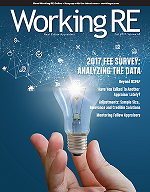 |
Services Offered this Issue
> American Society of Appraisers > Adjustments CE (7 Hrs.) |
Accommodation of Personal Interest
By Tim Andersen, MAI
Most appraisers are likely familiar with the Conduct section of the Ethics Rule, which teaches us that appraisers must perform assignments with impartiality, objectivity and independence. However, that is not the end of the sentence. What’s at the end of the sentence makes all the difference.
In its entirety, this sentence reads, “an appraiser must perform assignments with impartiality, objectivity and independence, and without accommodation of personal interests.” That is: without accommodation of any personal interests—either our own or those of the client or the parties to the purchase and sale transaction.
Note as well that this imperative carries through to the Certification (SR2-3). Specifically, the second bullet point (lines 820, 821) states clearly that “[t]he reported analyses, opinions, and conclusions are limited only by the reported assumptions and limiting conditions and are my personal, impartial, and unbiased professional analyses, opinions, and conclusions.”
Therefore, the Certification makes it clear that the appraiser has not accommodated any personal interests, nor has the appraiser accommodated the personal interests of the buyer, seller, lender, brokers, title company, attorneys, reviewer, etc. The appraisal and report are therefore impartial, independent and objective, without which an appraisal report is just another marketing/advocacy tool to be used as a broker uses a CMA.
Fannie Mae is so concerned about appraisers being impartial, objective, and independent that it published a document called Appraiser Independence Requirements. This document makes it very clear that, “No employee, director, officer, or agent of the Seller , or any other third party acting as a joint venture partner, independent contractor, appraisal company, appraisal management company, or partner on behalf of the seller, shall influence or attempt to influence the development, reporting, result, or review of an appraisal through coercion, extortion, collusion, compensation, inducement, intimidation, bribery, or in any other manner…”
(story continues below)
(story continues)
Then, from this point, the document goes on to include nine scenarios which the above paragraph forbids.
Consider this hypothetical situation: you are appraising a large, rural property with 15 acres of rolling grass and pasture lands. However, it is specifically not a farm, the property is not in an area zoned for agricultural uses, and land-uses in the area are not transitioning from the current zoning (estate residential) to anything resembling pastoral use. Because the sellers thought it was quaint, they bought an old barn, had it transferred to the site and use it for storing the equipment necessary to maintain a rural 15-acre site, as well as other miscellaneous items (i.e., their junk).
After submitting the appraisal report to the lender, you receive a stipulation requiring that you remove the photographs of the interior and exterior of the barn since the mortgage investors will not fund an agricultural property. You write back indicating the property is not agriculturally oriented; rather, the barn merely stores equipment. The answer you get back is to remove the photographs of the interior and exterior of the barn. So, the question is, do you accommodate the interests of the lender, thus possibly creating a misleading report?
Each individual appraiser will have to answer this question for him/herself. However, removing the photographs to accommodate the interests of the lender could be construed as misleading. This is because it could appear the appraiser is trying to hide the barn, thus hide an unlawful agricultural use of the site, even though this is not true. Therefore, the problem is not so much the appraiser trying to hide an unlawful use of the site, which the appraiser clearly is not. The issue is the appraiser removing the photographs to accommodate the lender’s wishes. This is likely a misrepresentation because, in the Certification, the appraiser indicates the conclusions are his/hers. However, this is not the case.
(story continues below)

(story continues)
The appraisal’s conclusions (e.g., no barn) were dictated by the lender, and were not those the appraiser reached independently.
Appraisers need to accustom themselves to the fact that there are parties to a purchase and sale transaction who will try to influence the appraiser’s opinions. This happens despite what Dodd-Frank dictates. In addition to the lender, appraisers often have to deal with the buyer, seller or the real estate broker. Any of these parties will happily try to influence us. This is merely human nature. Our challenge under USPAP is to resist this pressure. We must provide the client/intended user with an appraisal report which is the result of independent, impartial, and objective analyses of all of the market factors that affect a property’s value. Therefore, we must resist the undue influence to which the various parties to the transaction will try to subject us to.
Now, let’s circle back to the Conduct section of the Ethics Rule. It is our challenge to perform appraisal assignments with impartiality, objectivity and independence, as well as absent any accommodation of personal interests. Those personal interests can be our own or of the parties to the purchase and sale transaction for which we are providing an appraisal. They will try to pressure us. We resist that pressure by maintaining our impartiality, objectivity and independence and by not accommodating any personal interests, either our’s or theirs. It is in this way that we act professionally. It is in this way that we promote and maintain a high level of public trust in what it is we do as appraisers.
> CE Online – 7 Hours (approved in 40 states)
How To Support and Prove Your Adjustments
Presented by: Richard Hagar, SRA
Must-know business practices for all appraisers working today. Ensure proper support for your adjustments. Making defensible adjustments is the first step in becoming a “Tier One” appraiser, who earns more, enjoys the best assignments and suffers fewer snags and callbacks. Up your game, avoid time-consuming callbacks and earn approved CE today! Sign Up Now! $119 (7 Hrs)
OREP Insured’s Price: $99
About the Author
Timothy C. Andersen, MAI is the author of the Expert’s Guide to a Defensible Workfile and has been in real estate and consulting since 1975. He is a commercial real estate appraiser, AQB-certified USPAP instructor, USPAP consultant, Special Magistrate for the Palm Beach County Value Adjustment Board, author, instructor and expert witness. Andersen now offers a new report and workfile peer review service to help you sharpen your report-writing skills and workfile preparation. By uncovering and correcting common mistakes and inconsistencies, Andersen puts his experience and expertise to work for you. Ensure a better future by improving your skills. One workfile review order includes a free copy of Andersen’s e-book Expert’s Guide to a Defensible Workfile ($49 value). OREP insureds enjoy 50 percent off this valuable review service, normally $250 and up for a residential appraisal report. Isn’t it time for a professional checkup from someone who’s on your side? For more on this valuable service you may contact Tim directly: maitca@bellsouth.net.
Send your story submission/idea to the Editor: isaac@orep.org




by Mike Ford, AGA, GAA, RAA, Realtor(r)
Outstanding article, and excellent example Tim! .
I’d also add removing photo of the barn is potentially to misrepresent whats actually there. Easily explained away, there is no justification for client to want it ‘sanitized.’
Having said this; from posts I know you read and the kind we all often see, it appears as many as 90% of all appraisals are performed with some degree of accommodation (if not all when we consider UAD formats).
Another important part of USPAP to keep in mind is that the reports have to be considered in the context of their intended use; reviewed from the perspective of a peer; and any omissions or non compliance also have to be considered in terms of intended users intended use and whether they are substantive and their impact on conclusions are substantial.
Its that last area that creates grey areas where none should exist. Client wants religious icons blurred for (false) fear of ECOA issues. Maybe part of appraiser shows in bathroom mirror taking photo (we all try to avoid it but sometime it is not possible to get a representative photo without it). I decline to blur photos on request. I still consider them to be an altered photo. I’ll try to avoid the troublesome areas when I can but if I cannot, then blurring is not an accommodation I am willing to do. Many disagree on this and similar areas. Happy Hanukkah and Merry Christmas to all.
-by Rachel Massey
Hi Timothy, good timely article. Well written and to the point. Thank you for writing it.
-